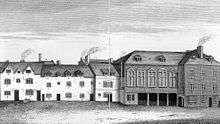Francis Barrington
Sir Francis Barrington, 1st Baronet of Barrington Hall, Essex (ca. 1570 – 3 July 1628)[1] was an English lawyer and politician who sat in the House of Commons in two periods between 1601 and 1628.
Life
Barrington was the eldest son of Sir Thomas Barrington of Hatfield Broad Oak, Essex (died 1586) and his second wife Winifred Pole (b. aft. 1521 or in 1525), youngest daughter of the 1st Baron Montagu.[2] He was educated at Cambridge University.[3]
In 1601, Barrington was elected Member of Parliament for Essex.[4] He was knighted on 7 May 1603 on the accession of King James I of England at Theobalds House, Hertfordshire,[5]
Barrington had written in April 1603 for advice on clothes to meet the new king in April 1603. His tailor Edward Shaw in London heard that most gentlemen would wear black satin, velvet, or stuff (wool) costume for first meeting the king. For the coronation people were ordering white satin or ash colour clothes, heavily embroidered, and the cost of embroidery work had risen. Gold lacing would be cheaper alternative.[6]
In 1604 he was re-elected MP for Essex . He was called to the bar by Gray's Inn on 19 March 1605 or 1606.[7] On 29 June 1611, he was made a baronet, of Barrington Hall, in Hatfield Broadoak, County Essex, in the newly erected Baronetage of England.[5]
In 1621 Barrington was elected MP for Essex again. He was re-elected in 1624, 1625, 1626 and 1628 and sat until his death in 1628.
Marriage and issue
Barrington married Joan Cromwell, who died around 1641 with will probated on 14 December 1641, daughter of Sir Henry Cromwell and was therefore uncle by marriage to the future Lord Protector Oliver Cromwell.[8] They had nine children, four sons and five daughters.[2] Barrington was succeeded in the baronetcy by his oldest son Thomas.[2][9] Robert Barrington became an MP for Newtown.[10]
Notes
- "Leigh Rayment - Baronetage". Retrieved 8 April 2009.
- Burke, John (1841). John Bernhard Burke (ed.). A Genealogical and Heraldic History of the Extinct and Dormant Baronetcies of England, Ireland and Scotland (2nd ed.). London: Scott, Webster, and Geary. p. 43.
- "Baryngton, Francis (BRNN580F)". A Cambridge Alumni Database. University of Cambridge.
- Browne Willis Notitia parliamentaria, or, An history of the counties, cities, and boroughs in England and Wales: ... The whole extracted from mss. and printed evidences 1750 pp176-239
- Collins, Arthur (1741). The English Baronetage: Containing a Genealogical and Historical Account of All the English Baronets. vol. I. London: Thomas Wotton. pp. 71–72.
- HMC 7th Report (G. A. Lowndes) (London, 1879), p. 542.
- "ThePeerage - Sir Francis Barrington, 1st Bt". Retrieved 4 January 2009.
- Courthope, William (1835). Synopsis of the Extinct Baronetage of England. London: G. Woodfall. p. 16.
- Noble, pp. 46,47
- Lowndes, G. Alan (1878). "The History of the Barrington Family". Transactions of the Essex Archaeological Society. I (New Series): 251–273.
References
- Mark Noble (1784). Memoirs of the Protectorate-house of Cromwell: Deduced from an Early Period, and Continued Down to the Present Time,..., Volume 2, Printed Pearson and Rollason.
| Parliament of England | ||
|---|---|---|
| Preceded by William Petre John Wentworth |
Member of Parliament for Essex 1601–1611 With: Henry Maynard 1601 Sir Edward Denny 1604–1611 |
Succeeded by Sir Robert Rich Sir Richard Weston |
| Preceded by Sir Robert Rich Sir Richard Weston |
Member of Parliament for Essex 1621–1628 With: Sir John Deane 1621–1622 Sir Thomas Cheek 1624 Sir Arthur Harris 1625 Sir Harbottle Grimston 1626–1628 |
Succeeded by Sir Harbottle Grimston Robert Rich, Lord Rich |
| Baronetage of England | ||
| New creation | Baronet (of Barrington Hall) 1611–1628 |
Succeeded by Thomas Barrington |
